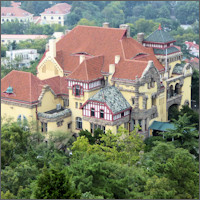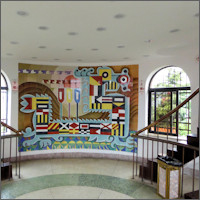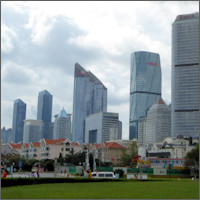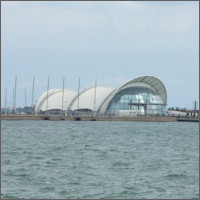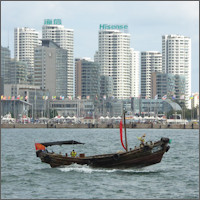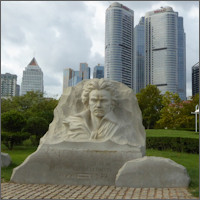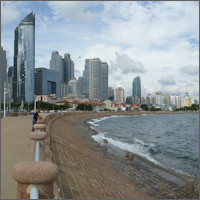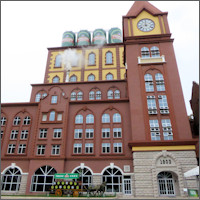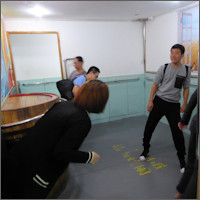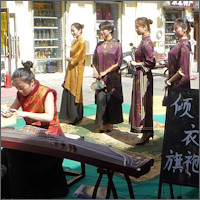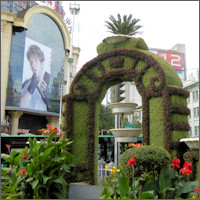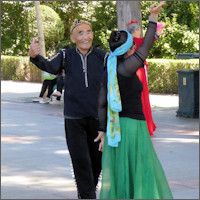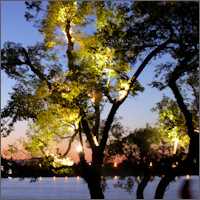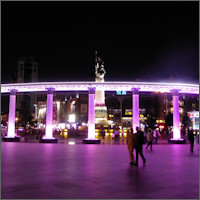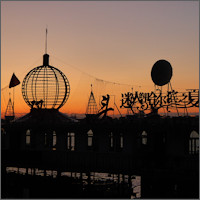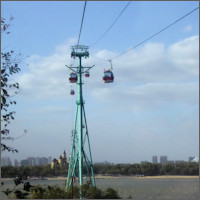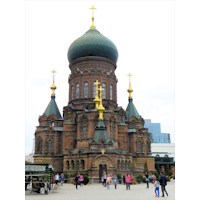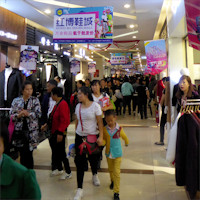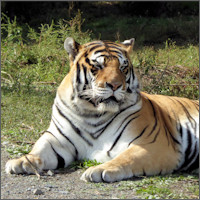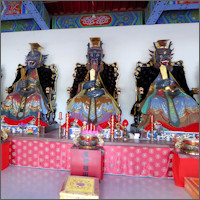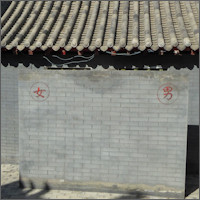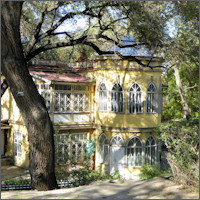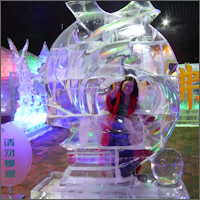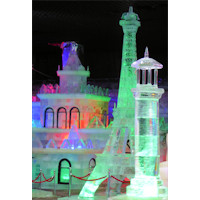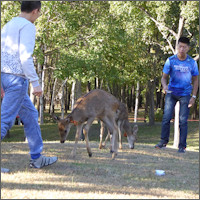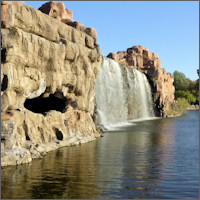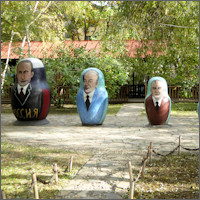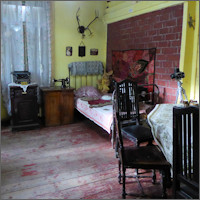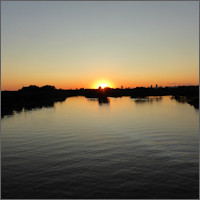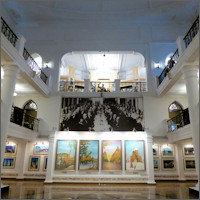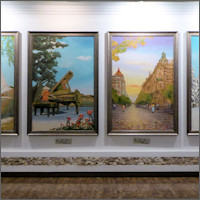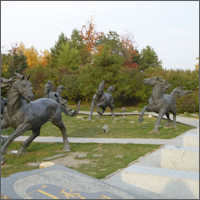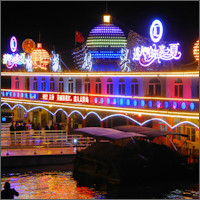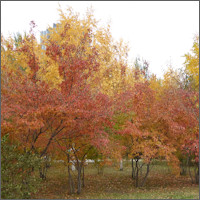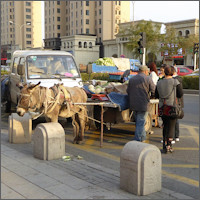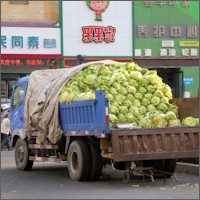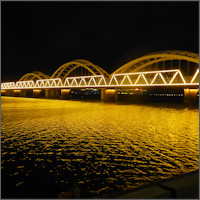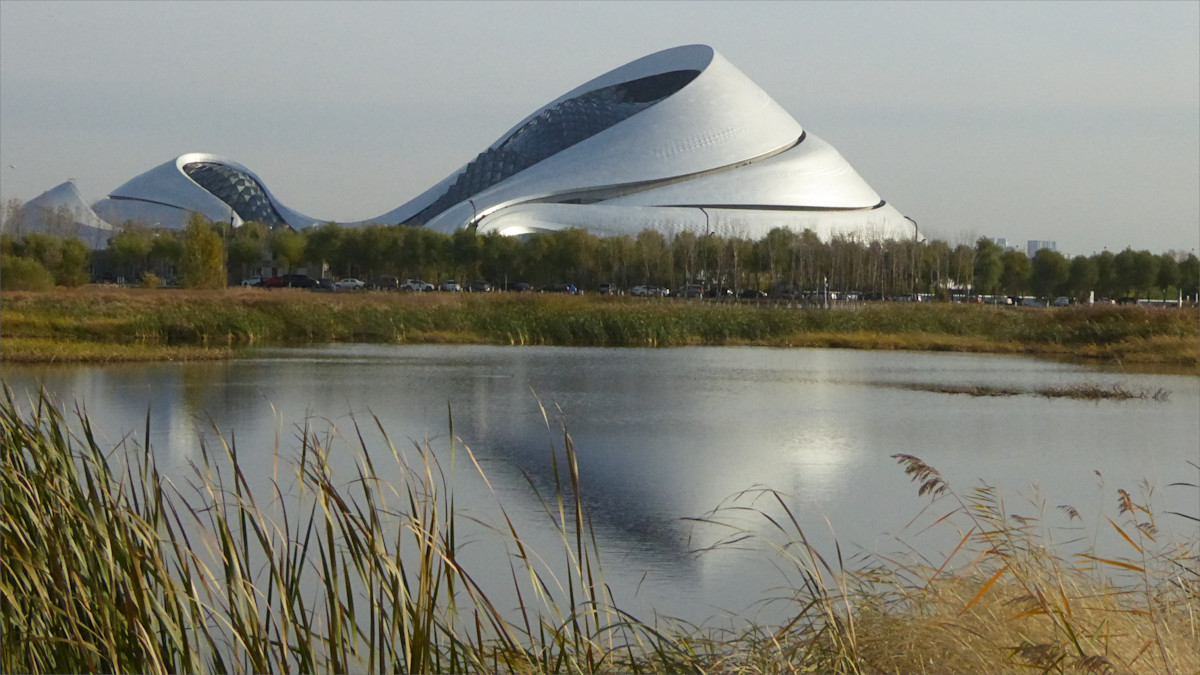
The Journey - 2017
In 2017, my journey through China began with a delightful two-day stop in Qingdao, renowned for its Tsingtao beer and intriguing German heritage.
Afterwards, I spent five weeks in Harbin, a city that holds a special place in my heart. It offered the perfect blend of study and exploration, though I was fortunate to experience it during pleasant weather, avoiding the bitter cold of the winter season when temperatures plummet to -30°C or even lower.
An extraordinary event awaited me in Shanghai, where I attended the Shanghai Masters ATP tennis tournament for two days. I had the privilege of watching matches featuring many top-ranked players such as Roger Federer—my all-time favorite athlete—and Rafael Nadal.
Since Suzhou, a city known for its rich history and breathtaking beauty, was just a short train ride away from Shanghai, my friend June and I embarked on a day trip there.
The next leg of my journey took me to Japan, specifically Osaka and Kyoto, where I reunited with my friend Yangjie. Since these experiences don't directly align with the focus of this blog centered around China, I may consider sharing them in the future on adventureasia.ca.
Finally, my last destination was Chongqing, a truly unique mega city that stands unmatched among China's bustling metropolises.
This trip was again filled with countless highlights that left an indelible impression on me. It's no wonder I fell in love with this remarkable country.
Enjoy wandering around with me in Harbin, my second destination, while I prepare the next post featuring Shanghai and Suzhou.

During my brief stopover, Qingdao left a lasting impression on me with its array of captivating attractions. From the meticulously designed 40-km long waterfront to the intriguing Tsingtao Beer Museum, I immersed myself in the city's rich cultural heritage and enjoyed its countless breathtaking views.
Being of German descent myself, I was naturally drawn to the historical connections and the remarkably preserved German-style architecture.
One of the waterfront's standout features is its serene ambiance. The wide waterfront park separates it from the hustle and bustle of traffic, creating a peaceful oasis. The architectural arrangement adds to its charm, with beautiful lower buildings closest to the waterfront, followed by medium-height structures, and finally, the high-rises in the background. This thoughtful design ensures a visually pleasing environment for a leisurely and tranquil stroll.
No visit to Qingdao would be complete without a trip to the renowned Tsingtao Beer Museum. The museum's exhibitions showcased the brewery's fascinating history and brewing techniques in various entertaining ways. However, the highlight of the museum was undoubtedly the Drunk House. This peculiar little room presented a mind-boggling experience as it seemingly defied gravity and left visitors disoriented, simulating the feeling of being highly intoxicated. The mystery behind its design intrigued me and I asked Google and ChatGPT but to no avail. Regardless of the secret, the Drunk House provided a delightfully fun and unforgettable experience that should not be missed.
My visit to Qingdao was a brief yet memorable encounter with a city brimming with surprises. Qingdao offered a unique experience unlike any other in China. With the desire to delve deeper into its treasures, I hope to return one day and uncover more of what this beautiful city has to offer.
Visited: German Governor's residence – Christ Church – Waterfront – May 4th Square – Signal Hill – Tsingtao Beer Museum – Zhong Shan Park
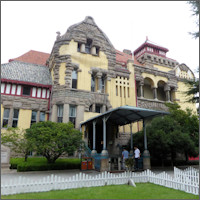
Step into history at the former German Governor's Residence, a testament to Qingdao's German occupation from 1898 to 1914.
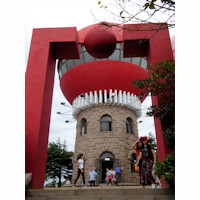
Signal Hill was used by the Germans as a signalling station. On top is a revolving tea house, offering stunning 360 ° views over the city.

Towering above all is the Parkson Plaza. In a country of architectural superlatives, this 213m tall high-rise with 49 floors is rather short and ranks only 1245 in the list of the tallest buildings in the world.
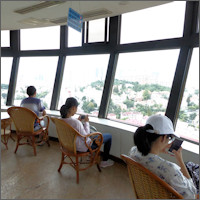
While I enjoyed the real city view, others were absorbed in the virtual world. China is home to 56 official ethnic groups. Lately, jokingly a 57th group has been added called dī tóu zú (低头族), which translates to "head-down tribe" and is used to describe people who are constantly looking down at their mobile devices.
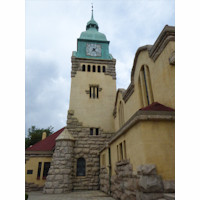
A church of many names, originally designed by German architect Curt Rothkegel and completed in 1908. According to the official sign on site, it was formerly called Gospel Church, then International Church. It can hold 1,000 people in service. Religious activities rehabilitated in 1980. It also goes by Christian Church, Lutheran Church, and Protestant Church.
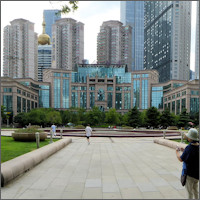
This and the next few photos are examples of the wide park and unique modern architecture style mentioned in the introduction.
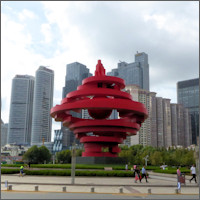
May 4th Square is named after the nationwide protest May Fourth Movement in 1919 that started in Qingdao and is recognized by the large red May Wind sculpture.
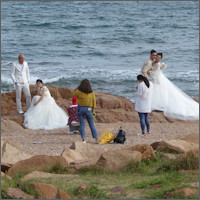
There are many popular wedding photography spots along the beaches. Following Chinese custom, wedding photos are captured before the actual ceremony.

It was a joy to witness the couples' creativity as they experimented with different outfits, props, and accessories. For a brief moment, I found myself assuming the role of a "wedding photography photographer".
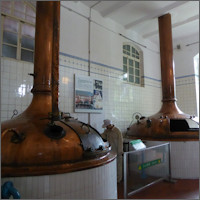
The exhibits explain the beer making process now and then in detail. I didn't know that it is so involved!
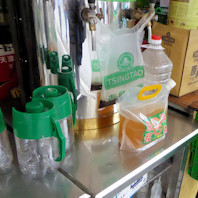
The entrance ticket to the museum includes one free 125 ml sample of unfiltered "raw" beer. If that's not enough, there are many beer gardens and stalls in the vicinity of the brewery where you can buy draft beer fresh from the factory. The beer is sold by weight… in plastic bags!

Welcome to Harbin, a city with a rich history that stretches back to the Qing Dynasty (1644-1912). Originally a small fishing village, Harbin witnessed significant development during the late 19th century as it became a vital hub for the construction of the Chinese Eastern Railway, connecting China and Russia. In the early 20th century, Harbin gained the nickname "Paris of the East" due to its vibrant arts and cultural scene, creating a cosmopolitan atmosphere. Despite the challenges faced during World War II and the Chinese Civil War, Harbin has successfully reclaimed its position as a major industrial and cultural center in northeastern China.
Looking to enhance my language skills, I enrolled in the Harbin Mandarin School. Similar to my experiences at CLI in Guilin and Keats School in Kunming, the school offered personalized one-on-one classes, comfortable accommodation, and a few engaging extracurricular activities. To my surprise, the living conditions exceeded my expectations, a detail I have enthusiastically shared in my blog post titled "High Life" in Harbin.
Harbin boasts a myriad of captivating destinations that make it difficult to decide where to start. With most attractions conveniently located within walking distance, I found myself strolling along wide sidewalks adorned with historical exhibits and pedestrian-only walkways. By turning left from the apartment complex, I entered the enchanting historical downtown, boasting a plethora of picturesque Russian-style buildings. On the other hand, a straight path led me to the magnificent 1-kilometer-long Songhua River Binzhou Railway Bridge, now transformed into a pedestrian bridge and one of my personal favorites. Crossing it granted me access to Sun Island, which hosts the renowned Harbin International Ice and Snow Sculpture Festival and a host of year-round attractions. Further away are the Siberian Tiger Park and the architectural masterpiece, Harbin Grand Theatre.
Allow me to conclude with an intriguing anecdote from Harbin Airport. As I approached the passenger entry door of the plane, I suddenly realized that my backpack felt surprisingly light. To my horror, I had unintentionally left my laptop behind during the security check! With a rush of panic, I quickly explained the situation to a crew member, who promptly sprang into action. After what felt like an eternity, but was actually only five minutes, he returned triumphantly, handing me my precious laptop. This incident showcased the exceptional service of China Eastern Airlines, leaving me to ponder whether such a swift resolution would have been possible at other international airports.
Visited: Binzhou Railway Bridge — Songhua Riverbank Park — Zhongyang Dajie — Zhaolin Park — Renmin Plaza — St. Sophia Cathedral — Cultural Park /Jile Temple (Temple of Bliss) — Grand Theatre (Opera House) — Daowai Mosque — Hongbo Underground Market — Flood Control Monument — Siberian Tiger Park— Sun Island — Ice and Snow Art Gallery — Unit 731 Exhibition Hall — Jewish Museum (former synagogue) — Songhua River Cableway — Lilac Park — Harbin Confucius (Wen) Temple

The Songhua River Binzhou Railway Bridge is about 1 km long and was built in 1900. It was decommissioned and converted into a pedestrian-only bridge and tourist attraction in 2014. One of my favourite and often walked pathways in Harbin.
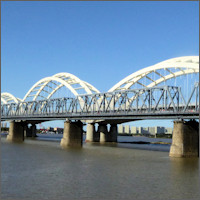
Two parallel bridges: the gray structure in the front is the aforementioned old railway bridge, the white one is the new highspeed railway bridge that replaced the old river crossing.
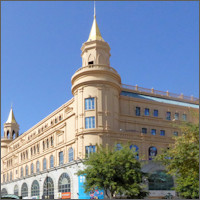
While some of the old Russian buildings in Harbin Old Quarter are meticulously kept, others have been untouched since a significant part of the Russian population left in the 1960s. Regardless of the condition of the buildings—diligently restored, gracefully aged, or in poor shape—I enjoyed the variety of styles.
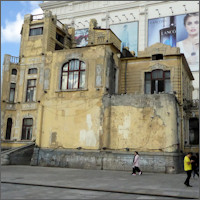
There's so much to see, and each building seems to have an intriguing story to tell. I wasn't able to uncover this one's mystery.
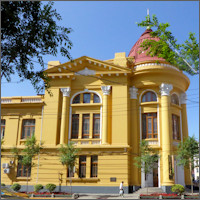
What a contrast to the previous picture!
Harbin Zhaolin Primary School is located in the east of Zhaolin Park on the south bank of Songhua River.
The school was founded in 1926, formerly known as "Park Primary School". In 1948, in memory of
the national hero General Li Zhaolin, the municipal government named the school "Harbin Zhaolin Primary School".
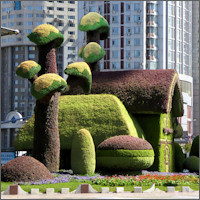
China truly has mastered the art of topiary (trimming and shaping shrubs or trees into decorative or artistic forms). This is only one of the countless outstanding creations around Harbin, but I've seen them in many other cities as well.

Many parks stretch along the Songhua riverbank providing a pleasant and engaging environment. Music seems to play a big role. I noticed many stores specializing in just one particular instrument. I could have easily erased the crane in the background, but its close resemblance to a bow was just too amusing.
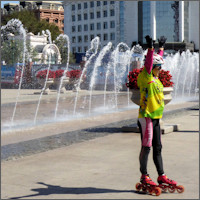
Musical fountains, designed to produce choreographed water movements and patterns in coordination with a musical soundtrack, are found in several locations.
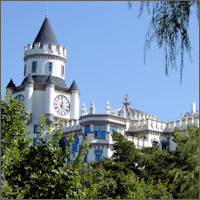
I've already mentioned the Binzhou Railway Bridge for crossing the river and getting to Sun Island. Two road bridges to the east and west also connect to the other side. Then there's a ferry service. When the river is solidly frozen during the winter months, some people walk across. But taking the cable car certainly is a fun experience that every visitor should take at least once!
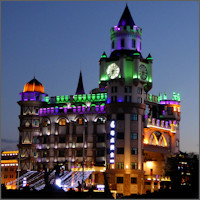
The Cableway stations on both sides are housed in colorful, castle-like buildings that stand out even more at night.

The St. Sophia Cathedral was built in 1907, expanded from 1923–32, closed during the Great Leap Forward and Cultural Revolution periods, and turned into a museum in 1997.
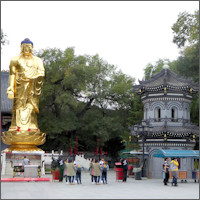
Jile Temple is the biggest Buddhist building complex in Heilongjiang and was constructed between 1921 and 1924.
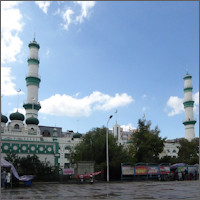
Daowai Mosque. It appears to be an active worship place and I didn't notice any visitor information, so I only saw the huge complex from the outside.
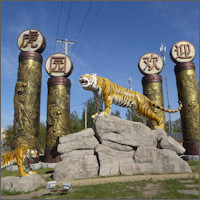
The Siberian Tiger Park is one of the largest captive breeding centers for Siberian tigers in the world.

Where animals roam freely and people are in cages. The first part of the visit was a ride in a caged bus, then we had the opportunity to walk through the caged overhead walkways as long as we wanted.
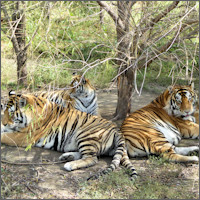
The park covers an area of over 1,440,000 square meters (355 acres). That's about 269 football fields or four times the size of Disneyland in California.
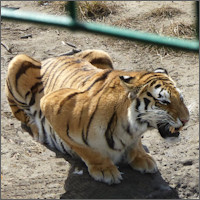
Several enclosures and habitats are designed to replicate the natural environment of the tigers. The park features various facilities, including a breeding center, veterinary clinic, and areas for public viewing.
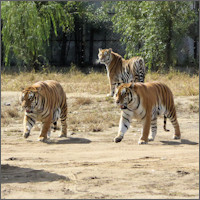
The park plays a crucial role in the conservation of Siberian tigers. It focuses on captive breeding to increase the population of these endangered animals.
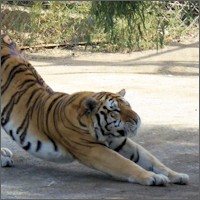
The park also conducts research and promotes public awareness about tiger conservation. It is estimated that there are around 27 to 34 Siberian tigers living in the wild in China and between 540 to 600 in Russia.
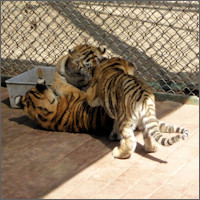
Cubs at play.
The offspring from the park's breeding program are sometimes reintroduced into the wild
as part of conservation efforts.

For a fee—I think it cost more than $100 (CAD)—visitors could hold a tiger cub for a short while and have their picture taken.
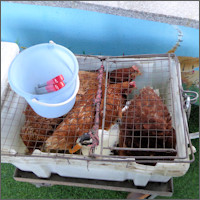
Visitors can buy strips of meat, live chicken, or even a whole cow to feed the tigers. I bought a little strip of chicken meat for about $2.

Irrationally I feel about the live animals like most city dweller. But how can we prevent extinction, replicate the natural environment, and ensure enough exercise if not by letting the tigers do what they do best: roam and hunt. That's the other side of the animal welfare coin.

I enjoyed the park and liked it much better than the usual small enclosures we typically find at zoos around the world. My only question is, why breed so many if there's hardly any territory left where they can be released? Recent reports of a wild tiger straying into a village and injuring a local resident made the rounds on social media…
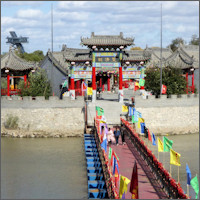
Let's explore Sun Island, also called Taiyang Island (taiyang = sun).
The colorful Taiyang Monastery or Taiyang Temple serves as a place for Buddhist worship,
meditation, and cultural activities.

In addition to its religious significance, the Taiyang Temple on Sun Island is also an important cultural and educational center. It hosts Buddhist ceremonies, cultural performances, and exhibitions related to Buddhism and Chinese traditional arts.
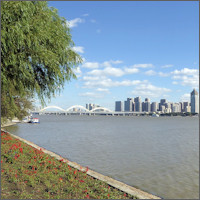
Looking across the water from Sun Island, you'll notice the old and new railroad bridges and the apartment complex where I stayed.
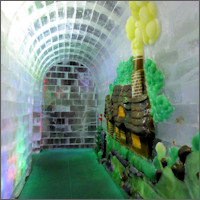
Did I miss out on the world-famous Harbin International Ice and Snow Sculpture Festival? Well, not entirely!
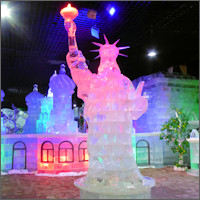
The Sun Island Ice and Snow Art Gallery covers a total floor area of 5,000 square meters, roughly equivalent to 25 tennis courts, and exhibits more than 100 ice landscapes.
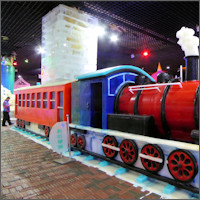
With 10,000 cubic meters of ice and snow, it is the largest indoor ice-lantern and snow sculpture gallery.

The red coats are provided, and I was glad to have one! One size fits all— even this cute little fellow. (Child's real face replaced with an AI created face.)

Several colorful buildings from the olden days are nestled in blooming gardens and surrounded by intricate statues.
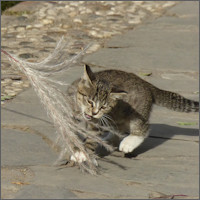
And a different kind of show, slightly more entertaining than the one performed by its human counterparts
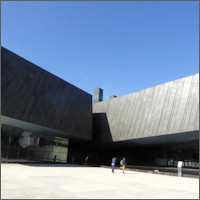
Unit 731 Exhibition Hall
Unit 731 was a covert biological and chemical warfare research and development unit of the Imperial
Japanese Army during World War II. The unit conducted brutal human experimentation on thousands of Chinese,
Korean, and other prisoners of war, as well as civilian populations.
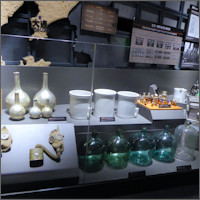
Some exhibits at Unit 731 Exhibition Hall.
The atrocities committed by Unit 731 include
vivisections, frostbite experiments, biological weapon testing, and other forms of inhumane research.
I couldn't help but be overwhelmed by a profound sense of sadness and a heavy burden on my heart.
As someone of German descent, I have experienced a similar feeling when I visited the concentration camp in
Dachau, Germany.

… because they are "carved and painted wood reliefs." This technique involves chiseling or carving a design into a soft wood surface and then applying paint to the raised, untouched areas, creating a textured and three-dimensional effect.
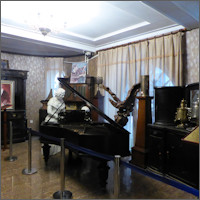
On the upper floors of the Jewish Museum are several furnished rooms giving a glimpse into the past. The delicate white plaster figures create a livelier atmosphere.
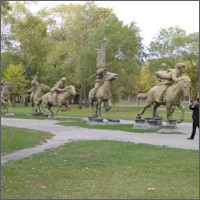
The cavalry troop statues at the Memorial Park of the Northeast Anti-Japanese United Army are just one example of the Chinese sculpting mastery. You just feel the power and movement in each unique horse.
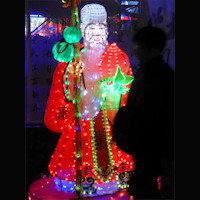
Most lanterns were in the shape of animals, mythical creatures, historical figures, and other objects.
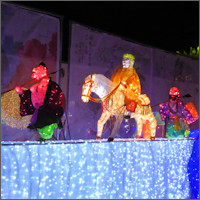
Some lanterns depicted scenes from famous historical novels such as Journey to the West (Monkey King).

The event was well attended, and even tall people had no chance to catch the performances because parents with children on their shoulders built an impenetrable wall.

The Harbin Confucius Temple (Wen Miao) serves as a cultural center, promoting the study of Confucian philosophy, ethics, and traditional Chinese arts.
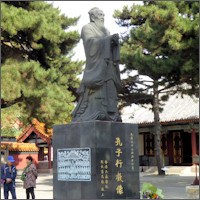
Confucius statue
One important annual event at Wen Miao is the Confucian Coming of Age ceremony, also known as the Guan Li.
This significant ritual in Confucian tradition marks the transition of young individuals into adulthood and
is typically held when they reach a specific age, often between 18 and 20 years old. This ceremony aims to
instill Confucian values, principles, and moral virtues in the young adults, emphasizing their
responsibilities as members of society.
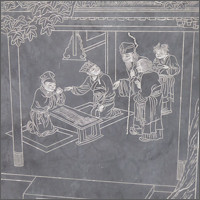
I've always been fascinated by this type of etched slate art. Countless scenes from life in the olden days are on display at Wen Temple.

Porcelain pillows – what a strange idea! What could be the reason behind it?
Coolness: Porcelain has natural cooling properties.
Hygiene: It was believed that porcelain pillows could help maintain cleanliness and hygiene.
Cultural Beliefs: Traditional Chinese medicine and Feng Shui principles played a role. Some believed
that using a hard surface for a pillow would help maintain proper alignment of the body and improve blood circulation.
Status and Symbolism: They were considered luxury items and often associated with the upper class and aristocracy.
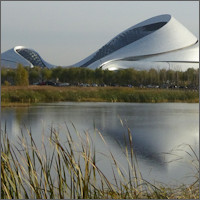
This architectural marvel is one of my favorites! Let me share some background information:
The Harbin Grand Theater was designed by the globally acclaimed architectural firm MAD Architects,
led by Ma Yansong. It was completed in 2015 and officially opened to the public in 2016.
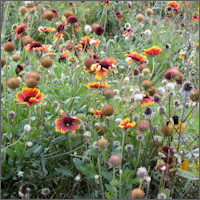
The theater's design aims to harmonize with the surrounding environment while reflecting the city's cold climate and winter scenery.
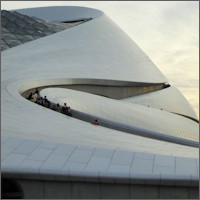
The exterior resembles two smooth, curvaceous shells, one large and one small, appearing like an ice shard or a snow-covered rock. The building's white aluminum panels create a visually stunning and futuristic appearance.
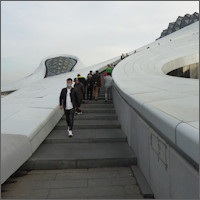
The Harbin Grand Theater has become a symbol of Harbin's cultural development and commitment to the arts. It plays a vital role in hosting a wide range of performances, including opera, ballet, classical music concerts, theater productions, and other cultural events. The theater aims to promote and showcase both traditional and contemporary artistic expressions.
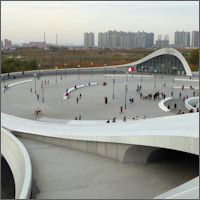
The Harbin Grand Theater has received significant recognition and numerous architectural awards for its innovative design.
And the coolest feature? Everybody can walk around in all outside areas of the building, including the big shell's grooves, at all times – free of cost!
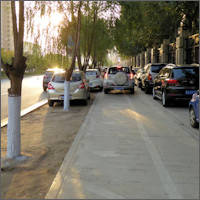
Sidewalks are not just for walking! Cars are parked on both sides, often for a fee, collected by a nearby parking attendant. So, pedestrians must always be on the lookout. This car drove backwards for at least 100 m to finally back into the empty spot on the left.

